Preface
Today’s City with Princes Street its gardens, and the magnificent New Town is
a far cry from the foul place it remained until the 18th century, when
the foundations of its transformation were laid by Lord Provost George Drummond. …
[Please click here to read more before you go on to the guided tour.]
 St
Giles High Church dominates the view from the roof of the
Camera Obscura (Photo: ©Tom
Mc Rae)
St
Giles High Church dominates the view from the roof of the
Camera Obscura (Photo: ©Tom
Mc Rae) |
The Guided Tour
 leave out the standard Tourist places and the much vaunted Ghost Tours. If tempted
to join one of the latter be warned some occupants of the old buildings occasionally
throw buckets of water down on noisy participants. We’ll stick to the area
of and around The Royal Mile for most of my tour looking at places most visitors never see. All of the tour
will take 3 days or more.
leave out the standard Tourist places and the much vaunted Ghost Tours. If tempted
to join one of the latter be warned some occupants of the old buildings occasionally
throw buckets of water down on noisy participants. We’ll stick to the area
of and around The Royal Mile for most of my tour looking at places most visitors never see. All of the tour
will take 3 days or more.
Remember that Edinburgh’s hills make San
Francisco’s look like tuffets, and take a folding umbrella around as there
can be surprise rainstorms. On the route I am describing numerous pubs en route will act as rest spots. Nowadays one can even order Chardonnay without being
thrown in the gutter. Never just ask for a whisky or even a Scotch, every
pub has a huge selection of single malts and blendeds. You’ll find the natives
very friendly, but be warned they love pulling visitors’ legs. Just don’t
argue with them about fitbaw (football)!
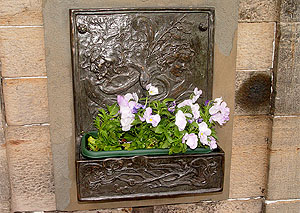 The
Witchcraft Memorial adjacent to Edinburgh Castle (Photo: ©Tom Mc Rae)
The
Witchcraft Memorial adjacent to Edinburgh Castle (Photo: ©Tom Mc Rae) |
The Mile starts at The Castle, enters The High Street and continues by that name
until a set of traffic lights at St Mary’s Street transforms it to The Canongate (locals call it The Cannygate), so called as it was the favoured walk of clergy at Holyrood Abbey. There are
several shops in The Canongate where Scottish clothing can be purchased cheaper
than in the Princes Street tourist
traps.
Starting from the Castle Esplanade walk down on the left and look for a wall
jutting out adjacent to a pub … Here you’ll find The Witchcraft Memorial, walked past unnoticed by thousands each day. It usually has flowers planted
in it. Read the text and admire the workmanship on the bronze plaque. This
is the only witch memorial of which I am aware.
After reflecting on all the horror and
injustice of the Witch Trials you may need a drink. Over on the right hand
side and slightly further down is the Museum of the Scotch Whisky Association. Even if you are teetotal the displays are worth seeing, including a ghost that
comes out of a bottle to explain blending, and a ghost train type ride in
half whisky casks through a set of historical tableaux. There is also an
excellent restaurant and an infinite range of brands of Scotch can be found
in the shop.
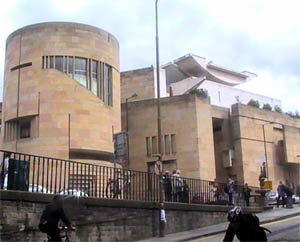 The
Museum of Scotland (Photo: ©Tom Mc Rae)
The
Museum of Scotland (Photo: ©Tom Mc Rae) |
A little further down on your left you’ll
find The Camera Obscura with one of the best views of the City Skyline from its roof. The old periscope-like
projector gives good views of the City on its circular table and a large
display of optics-based material keeps people occupied while waiting to enter
the Obscura chamber.
Walk on down to the traffic light crossing with George IV Bridge, a street which
runs horizontal to the High Street, and you have an option. One can either
go straight on down towards St Giles or turn right moving along George IV
Bridge to Chambers Street on the Left. (While in George IV Bridge Harry Potter
fans may care to have coffee in The Elephant Cafe where Jo Rawlings wrote
the first book.) To your left in Chambers Street we find The Old Royal Scottish Museum. Of classic Italianate design, and the more comprehensive, recently built Museum of Scotland. This is your destination. On its lower levels are some ancient magical items
as well as a complete Viking Grave and several treasure hoards. You’ll find
many ancient stones with symbols claimed by the ignorant to be Knight Templar,
Fact is they are much more ancient than that.
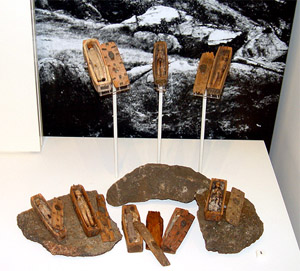 Miniature
coffins at the Museum of Scotland
(Photo: ©Tom Mc Rae)
Miniature
coffins at the Museum of Scotland
(Photo: ©Tom Mc Rae) |
The must
see for just one visit are the mysterious miniature coffins on, if I recall right,
the third level. If in doubt ask a uniformed keeper.
Back in the mid 1880s a local gentleman
was walking through The King’s Park (Never Queen’s it is associated with
our Scots King David) when he saw some local urchins stoning items on the
ground. On investigation he found several tiny coffins exquisitely crafted
each with a clothed occupant. Kids told him they’d moved a rock on Arthur’s
Seat and found them in the cleft. Purpose? Your guess is as good as anybody’s.
The same area has a stack of old Scots magical items. Take your camera as
photography is allowed. Downstairs in the older Royal Scottish Museum, is
an excellent café. Museums interconnect. Try and be around in the Old Museum
around 12 noon when the bizarre Milleum Clock puts on its show.
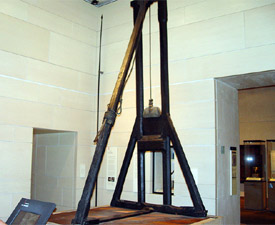 The
Edinburgh Maiden, a beheading machine in use 175
years before the French Revolution, on display at the
Museum of Scotland (Photo: ©Tom
Mc Rae)
The
Edinburgh Maiden, a beheading machine in use 175
years before the French Revolution, on display at the
Museum of Scotland (Photo: ©Tom
Mc Rae) |
On leaving the Museum go back up to the
junction and walk over to Greyfriars Churchyard, passing the statue of Greyfriars Bobby. (This statue is not all that old, the original having been stolen by metal
thieves in the late 1940s.) The churchyard is where the Covenant was first
signed and is full of interesting graves. Ironically, many of the original
signatories were later confined here by religious opponents. A lovely old
stone near the entrance shows a memento morii. Look out also for Greyfriar’s Bobby’s gravestone in pink marble.
 The
entrance to Greyfriar’s Churchyard (Photo: ©Tom Mc Rae)
The
entrance to Greyfriar’s Churchyard (Photo: ©Tom Mc Rae) |
If you don’t opt for this diversion carry
on down the right hand side of the High Street and walk towards St Giles High Church where I was baptised. Look out for the old public reticulated water fountain you can find at least thee others on your walk. Walking past the church look
for a rather revolting heart marked on the ground and usually covered with
saliva. This is The Heart of Midlothian and marks the site of the old Tolbooth jail. Spitting on it is an old local
custom, nobody knows why but I suspect it started in connection with hatred
of the jail.
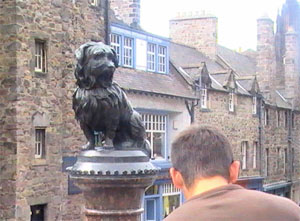 Greyfriar’s
Bobby’s gravestone (Photo: ©Tom Mc Rae)
Greyfriar’s
Bobby’s gravestone (Photo: ©Tom Mc Rae) |
Just past the church the pavement opens
into a yard where The Merkat Cross is situated. An ancient site for proclamations, the present version is of later
date; I saw Queen Liz proclaimed there with full ceremonial in the 1950s.
Legend has it a strange hooded figure stood in the original on the night
after the Battle of Flodden announcing the names of all the Scottish dead.
Look at the ground here for a strange octagon containing a cross composed of a vertical and a diagonal cross. Nothing to do with religion this
is one of the City’s old execution sites of which there are several around
the old city. The beheading machine used here may still be seen in the Museum
of Scotland. Now look upwards at the Church’s tower and locate an added cylindrical slotted turret. This was built so militia could fire down on rioting 18th century crowds, but
I doubt it was ever used. Behind the church is the original Scots Parliament
building and Law Courts, among its clients being Burke and Hare. John Knox
is buried in an unmarked grave near his statue in this area.
 The
High Street Execution Site Cross (Photo: ©Tom Mc Rae)
The
High Street Execution Site Cross (Photo: ©Tom Mc Rae) |
Across the road is the old City
Chambers. If you don’t mind steep climbs up and down steps in the gloom the adjacent Mary King’s Close is a must, guided tours take visitors around this labyrinth with its dwellings once hit
by Plague and a strange room haunted by the ghost of a young girl. I
can testify to this room’s strange vibes. The Close buildings once towered
up high, but this portion of the old City was buried under new works
in the 18th century.
Move on down the street and you will see a very tall church spire. This is the Tron Kirk where the public Tron or standard weighing machine was set up. The church was
unused for many years and an enterprising local even used it as an illicit
whisky still with a pipe set up the spire to vent the fumes. It is now the
all important Tourist Centre. Cross the street and you’ll see John Knox’s House on the left hand side jutting out; walk towards it. The adjacent Closes run
down to where the Nor Loch used to be. Drained in the 18th century this foul
stretch of water had all the effluvia from butchers and tanners thrown into
it with other filth. Women condemned to death were often drowned in its filthy
water. The stench from the loch permeated the old City and probably gave
rise to the traditional tune “The Flowers of Edinburgh.”
Adjacent to the dwelling allegedly occupied
by Knox is another public water outlet and over on the right hand side of
the road is the fascinating Museum of Childhood which invokes many an adult’s memory; like most public museums entrance is free.
Moving on you’ll soon reach another traffic light crossing with St Mary’s
Street on the right and Jeffrey Street on the left. Here the High Street
is transformed into The Canongate. Cross over to move on down the Cannygate. (If you need to find one of Edinburgh’s rare Post Offices there was still one
towards the bottom of St Mary’s Street on the right painted vivid red.) Having crossed make a quick diversion into Jeffrey Street on the left with its excellent view of Calton Hill. On the hill you’ll see what appears to be an ancient Greek ruin. This was intended
to be a memorial to the Battle of Waterloo built by public subscription.
Funds were insufficient causing it to be nicknamed Edinburgh’s Disgrace to this day. Napoleon went over big with the Common People of Scotland, hence
the apathy. You should also see, lower down, a tall obelisk in Calton Cemetery. Ignorant Edinburghers call this “Cleopatra’s Needle.” Truth is it’s a memorial to five unfortunate men unlawfully transported to Australia
for daring to promote votes for ordinary people; only one returned. The public
eagerly subscribed to that project.
To the right of The Disgrace is a narrow
telescope like tower with a flagpole bearing a large ball on top, this is
a memorial to Lord Nelson. The ball is a later addition and drops immediately
the Castle’s One o’ Clock Gun is fired. Local kids will assure you the gunner’s
aim is always accurate. Truth is it is synchronised electronically with the
gun. Why at One not Noon? We Scots are noted for our thrift. What looks like
an old castle is also set on the hillside, this is the remains of the now
disused Calton Jail. A black flag was flown in its heyday when a hanging
was scheduled. It replaced the Tolbooth Jail we passed earlier. There is
also an insignificant memorial to Burns often confused with another dedicated
to the philosopher Dugald Stewart.
Walking along Jeffrey Street will eventually
bring you to The Edinburgh Dungeon, a macabre, historically inaccurate, tourist spot. But it’s great fun. Apart
from this the cross streets have little else to recommend them. Move on back
down the Canongate sticking to the right. You’ll come to St John’s Close which contains the HQ of the Scottish Royal Arch and the Knights of St John. Lodge Canongate Kilwinning is adjacent. There is another execution cross just outside the Close in the
centre of which idiots ignorant of its significance have set a white St John’s
Cross. Do have a chuckle en-passant. On the left watch for an adjacent Close the entrance of which bears the gilded
arms of The Shoemakers’ Guild. Many mistake it for a Masonic Lodge.
Two adjacent pointed pillars on plinths indicate the gates of Moray House (my old school). In a summer house of this building the scurrilous 1707 Union
of the Parliaments Act was signed. Officials did the dirty deed there as
the People wanted their blood elsewhere! Locate the house’s small balcony.
There was a wedding party in progress when captive Montrose came up the hill
in his prison cart. It stopped just opposite as the jailers knew his old
enemy The Duke of Argyll was present. Legend has it Argyll hadn’t the guts
to look Montrose in the face but peered out from behind a curtain. Montrose
was later hanged higher up the road at the site outside St Giles.
Moving on there’s a double-gabled white
building. Originally Huntly House, it’s now The Museum of Edinburgh. (The Huntly’s were mortal enemies of the Moray’s). Among fascinating items
here you’ll learn how an Earl St Clair at the time of James VI got his nephew
and fellow pupils of The Royal High Academy out of a murder charge. There
is also a wonderful model of the old Canongate.
Across the street is a large building with a gilded clock sticking out the front.
This is The Peoples’ Story Museum, well worth a diversion. Here you can see how ordinary people lived in earlier
times and even learn more about those Five Scottish Martyrs and their obelisk.
While photography is permitted in the Museum a declaration must be signed
that any photographs will neither be distributed nor used commercially. The
building was originally the Canongate Tollbooth. Look for the cylindrical
tower similar to that at St Giles.
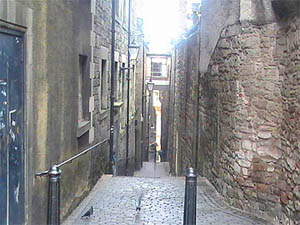 A typical “close” opening
off The High Street
(Photo: ©Tom Mc Rae)
A typical “close” opening
off The High Street
(Photo: ©Tom Mc Rae) |
A little further down we find Holyrood
Kirk and its fascinating churchyard where many’s a distinguished citizen lies interred.
Dugald Stewart is among them and on the church wall to the right of the
building is what is alleged to be the grave of David Riccio, Mary Queen of Scots’ confidant and maybe lover. It was transported here from
its original location at Holyrood Abbey. This kirk, by Edinburgh standards,
is not really all that old being built by order of James II. The Holyrood
congregation was moved from the Abbey so the re-created Knights of the
Thistle could have the church for their chapel. Stick to the left and
peek in a few Closes.
Closes? Originally narrow alleys leading to large tenements, tenants used their
key to open the barred door then closeing (sic) it. Originally visitors gained access by running a metal ring over a serrated
bar but remaining examples of those are rare. The better your Class of society
the higher you lived above the stench.
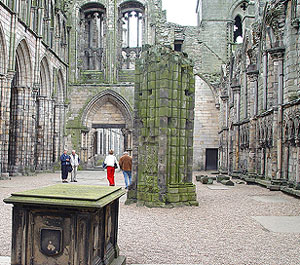 Tom
Mc Rae and his Toni (facing the camera) visiting the ruins
of Holyrood Abbey, stone sarcophagi being visible on the right (Photo: ©Tom Mc Rae)
Tom
Mc Rae and his Toni (facing the camera) visiting the ruins
of Holyrood Abbey, stone sarcophagi being visible on the right (Photo: ©Tom Mc Rae) |
Stay on this side but watch out on the right
for The Scottish Parliament Building, a fiasco 800% at least over Budget and only completed about 4 years after schedule.
To me it resembles a huge cruise liner crashed into a beachside resort by
a tsunami. Opposite this monstrosity look out for White Horse Close. Walk in and look at the lovely building in front of you. Seem familiar? Well
millions of copies of its image has been reproduced and distributed worldwide
on labels for White Horse Scotch. Bothwell and Dr Johnson were among guests
when the Inn was operational.
The Canongate soon ends at the gates of Holyrood Palace but the old houses before
the palace were Sanctuary buildings for centuries. The poet Coleridge was
a regular resident sheltering from his debtors; all in Sanctuary were allowed
to walk in the adjacent King’s Park on Sundays.
I’ll leave the Palace to its Guides but get Ye into the ruined Abbey. Although partially damaged by two English invasions under Henry VIII during
The Rough Wooing the major carnage was wrought by Edinburgh Protestants after
the expulsion of James II. Look for the stone sarcophagi that once held the
bones of Scots Royalty. These were desecrated as their ancient occupants
were, naturally, Roman Catholic. King, Queens, and Lords of Yore all destroyed ... Oh Bigotry!
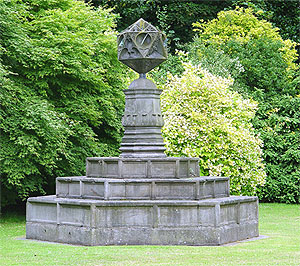
The Sundial in the gardens of Holyrood Palace are alleged to
have great occult and alchemical significance. Fact is the
symbols commemorate the marriage of James V to Marie
de Guise with Thistle and Fleur de Lys plus the Rose to
back James’ claim
to the English throne his grandson would
occupy in time. (Photo: ©Tom
Mc Rae) |
Under no circumstances miss a walk in the
Palace Gardens, only opened to us commoners in recent years. Enjoy the stunning
views but watch out for a beautiful stone sundial on a triple layered octagonal base. In his ponderous “Dwellings of the Philosophers.”
The mystical charlatan Fulcanelli gives this esoteric attributes despite
never having seen it. The beautiful artefact was found dumped in a corner
of the grounds and reset up during 19th century Palace restorations, the
base being a new addition. Fulcanelli claims the Thistles depicted symbolise
the Order of Knights of the Thistle to which he ascribes Templar-like secret
activities. Fact is the Order was set up by James IV but it only existed
briefly and was re-established by James II in a futile attempt to curry favour
with the Scots Lords. The sundial was originally erected on the orders of
James V to commemorate his marriage to Marie de Guise and bears the arms of Scotland, Thistle, France, fleur de lys, and England, Rose. Despite Fulcanelli’s imaginative claims the Rose, in this
context, has no mystical significance. James V regarded himself as rightful
claimant to the English throne just as his daughter was later to do at her
mother’s instigation, hence its inclusion. Fulcanelli even gets the King
who built it wrong, the cypher on it is IVR (Iacobus Vth Rex), as I recall
he had it as Charles 1st. Nonetheless the sundial is a beautiful artefact,
possibly created by the same architect who designed Linlithgow’s Falkland
Palace.
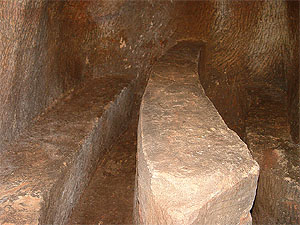 The
Gilmerton Cove was used as a drinking den in 18th and
19th centuries, but it is much older and of unknown original
purpose. (Photo: ©Tom Mc Rae)
The
Gilmerton Cove was used as a drinking den in 18th and
19th centuries, but it is much older and of unknown original
purpose. (Photo: ©Tom Mc Rae) |
Thus ends our walking tour. Now ...
To The Gilmerton Cove on the City’s edge. If you can handle stairs this is a must. You can either book at The Tron mentioned above or your hotel should be able
to organise something; two years ago the tour started at 7 pm. Have a look
and form your own opinion then reflect on Mc Rae trying to locate it while
drinking beer almost directly above in the 1960s. 
Other more distant venues where the Tron
could help? Cramond has an old Roman camp but they marched out a couple of years ago now, so don’t
expect to see them drilling. Then of course Rosslyn Chapel but beware of the rubbish some of the Guides spew out.
For those who are medically oriented The
Museum of Surgery is good value but it’s hard to find and opens only in the afternoon. To get
there start at the Tron, cross the road, and walk to the right, away
from Princes Street. A 10 minute walk will get you to Surgeon’s Hall
on the left with its massive gates, don’t enter there. Walk on to the
first street on the left (Hill Place I think) and you will come to an
attractive fenced garden in the middle of a square. You are behind the old Surgeons’ School so do not reflect on what may
remain buried in the garden.
Turn left when you see the Garden and the
Museum is upstairs in the last building on the left by the corner; look for
the sign. This Museum covers everything from old time surgery to modern techniques.
There are also wax images of some of Edinburgh’s great surgeons and anatomists
and relics of Burke and Hare.
For a range of top class restaurants take a walk down Leith Walk which runs off from the East End of Princes Street. About 5 minutes downhill
look for giraffe sculptures, adjacent to those is the OMNI cinema and restaurant complex with a wide range of international cuisine. For
those who like such things there are two adjacent night clubs. The road widens
here and on the other side are a few other good eating places. For curries
with a difference “The Ghurka Brigade” serves up wonderful Nepalese dishes. Turn right, walk up this side of the street
and take the first right again, then again into Broughton Street where there are two top fish and chop shops that deep fry just about anything.
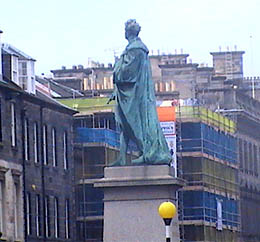 “Whazzup,
George?” (Photo: ©Tom Mc Rae)
“Whazzup,
George?” (Photo: ©Tom Mc Rae) |
Let’s end with a paradox. Walk along Princes
Street a few blocks, then turn uphill into Hanover Street walking on the right hand side. Note the imposing statue of George IV in full regal glory. Rather an optimistic depiction as he was merely 5’2” and
the same wide. But did a closet Jacobite do the sculpture? Cross George Street
and walk a few yards down the right hand side, carefully avoiding traffic,
have a look carefully at the statue from this perspective and you’ll understand
why giggling young lady students like to pose beside it. Is George waiting
for his mistress Mrs Fitzherbert?
As a finale cross the street again, walk
along with the statue behind you. Look for and enter The Dome which has to be one of the world’s most imposing pubs, serves great meals too.
And so ends the suggested tours around
my City.
Background
Reading
1.
Fact
To me the best recent book on Scots History
is Magnus Magnusson’s superb Scotland History of a Nation. Another beauty is Capital of the Mind by James Buchan which tells how Edinburgh launched The Age of Enlightenment.
Lots of information on the development of the 18th century City.
The Illustrated Guide to Rosslyn
Chapel by Rev John Thompson, Chaplain to the Earl of Rosslyn, when written in 1892
is excellent preparation for a visit to the Chapel. This new edition is
available from The Grand Lodge of Scotland’s website and Bro Robert Cooper, Curator of the GL Library and Museum, gives
an Introduction that is worth the cost of the book alone.
Robert Cooper’s recently published The
Rosslyn Hoax shatters all the garbage involving Knights Templar and Masonic influence in
the ancient Chapel.
2.
Fiction
The novels of Alexander McCall Smith involving
ordinary Edinburgh people are an excellent read. Try 44 Scotland Street or The Sunday Philosophers Club.
Ian Rankin’s detective mysteries involving
Inspector Rebus explore the City’s dark undercurrents of treachery and violence.
One of the latest is The Naming of the Dead; another, Set in Darkness, involves Rosslyn Chapel and shows the average local’s reaction to the current
nonsense.
Have
a great stay!
Tom
Mc Rae

